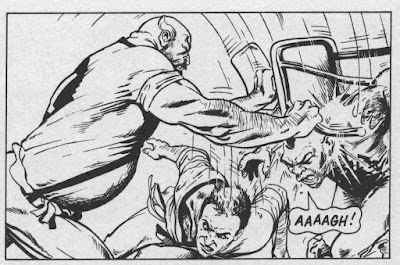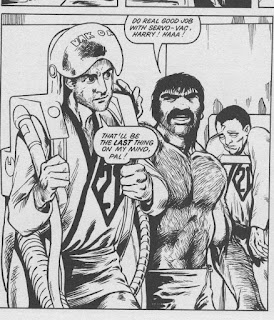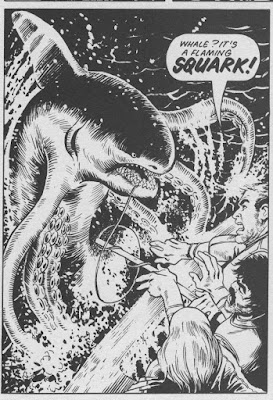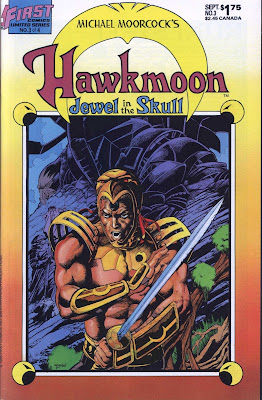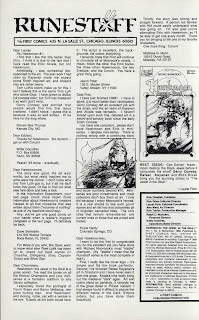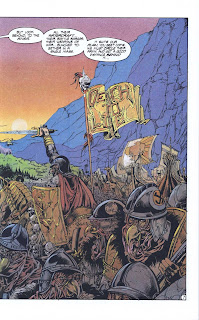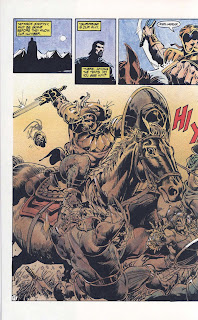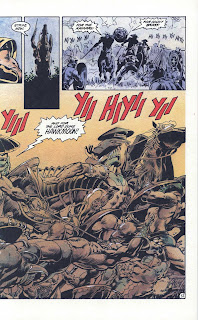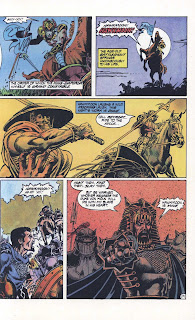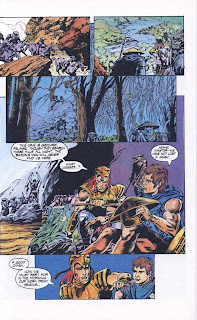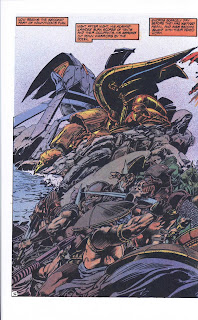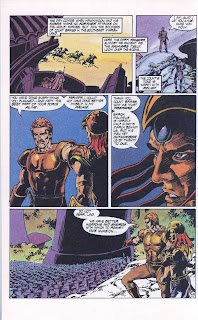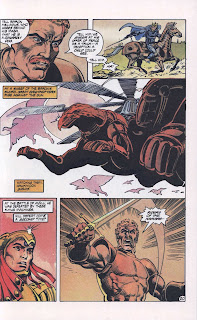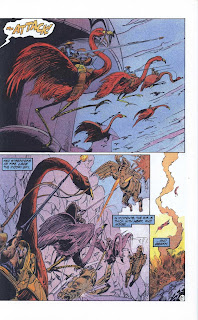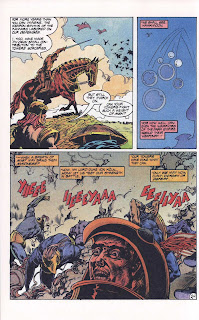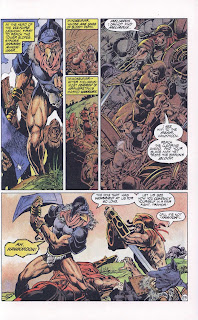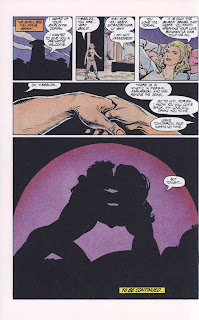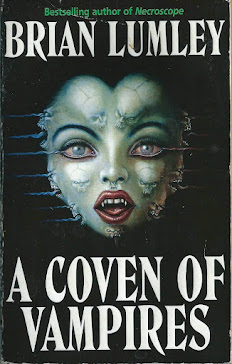Book Review: 'October the First is Too Late', by Fred Hoyle
2 / 5 Stars
‘October the First is Too Late’ first was published in hardcover in 1966; this Fawcett Crest paperback (160 pp) was published in July, 1970. The cover artist is uncredited, but probably is Paul Lehr.
The novel has an intriguing premise: through the action of an entity or entities unknown, in August of 1966, Earth is subjected to a ‘Timequake’ which places different geographic areas in different eras in the planet’s history.
In England, it’s still 1966, but in Western Europe, it’s 1917, and World War I is raging. In Greece, it’s 425 B.C. And ominously, in Russia and China, the entire landscape is a featureless sheet of glass – suggesting the far, far future.
The first-person narrator, referred to as Richard or Dick, is a skilled pianist and composer of avant-garde works. By virtue of being a friend of the talented mathematician John Sinclair, Dick is invited along on exploratory trips made by a bewildered UK government to see the extent and breadth of the Timequake’s effects on the planet.
But as the intrepid British explorers are to discover, the likelihood of reversing the altered state of the Earth may not just be impossible, but unadvisable……….
I found ‘October’ to be a disappointment. Despite having one of the more interesting premises in sf, it really does very little with it.
At the time he wrote the novel, Fred Hoyle must have been obsessed with music and musical creativity, because large segments of ‘October’ are devoted to expositions on playing music; composing music; the effects of music on the emotional and psychological state of the listener; how music is transformed, but remains the same, over the passage of the centuries; etc., etc. And this is all classical music that is being dealt with, of course. I was thankful ‘October’ didn’t revolve around a reverential treatment of Jazz, an exasperating affectation on the part of so many novels, but still………..
I won’t disclose any spoilers about the novel’s denouement, save to say that I found it underwhelming and contrived – as if Hoyle, in setting up his premise of a Timequake, was indifferent as far as resolving it.
The novel’s prose style, like those of Hoyle’s other novels, is clean and fast-moving, which helps to some extent in mediating the overemphasis on Music Theory and Practice. But when all is said and done, I can’t give ‘October the First is Too Late’ more than two stars.
Monday, June 19, 2017
Friday, June 16, 2017
Harry 20 on the High Rock
Harry 20 on the High Rock
Alan Davis (art) and Gerry Finley-Day (story)
2000 AD / Rebellion, August 2010
'Harry 20 on the High Rock' first appeared in the 23 October, 1982 issue ('Prog') 287 of 2000 AD. It ran in periodic fashion, sharing space with features like Judge Dredd, Robo Hunter, Time Twisters, Ace Trucking Co., and Rogue Trooper, until Prog 307 (12 March 1983).
This trade paperback compiles all of the episodes, along with a sketch section.
The story takes place in the near future, when all criminals are housed in a massive orbiting prison, known as the High Rock. Every one of the 10,000 inmates are known by their first name and the number of years in their sentence. After getting convicted of smuggling food to a humanitarian group in the Equatorial Zone of Earth, Harry Thompson is sentenced to 20 years on the High Rock, hence the 'Harry 20' moniker.
The High Rock is run by the feared Warden Worldwise, who has the freedom to impose any policy he so desires. Discipline is strict, with infractions earning a prompt beatdown from the sadistic guards. Inmates who cross the line can find themselves dispatched to the 'gravy train', a work detail in which inmates are given thin spacesuits and tasked with chipping ice off of the vents on the exterior of the Rock.
Needless to say, Harry 20 has every intention of escaping the High Rock, and he's willing to take his share of beatings if it brings him closer to his goal. But Warden Worldwise and the prison guards aren't the only obstacles Harry must overcome if he is to have any hope of succeeding. Other inmates - notably Big Red, the most dangerous and homicidal of all the Rock's prisoners - have it in for Harry 20.
And needless to say, if Harry 20 is going to escape the High Rock, a high body count is definitely in the offing...............
'Harry 20 on the High Rock' is one of the best series to appear in the early years of 2000 AD. This is due to Gerry Finley-Day's script, which keeps the narrative simple and straightforward, while also working in various twists and surprises that keep the reader in suspense till the very last page. It's never entirely clear if Harry will experience a happy ending, and this keeps the story from becoming too formulaic.
'Harry 20' relies on sharp little episodes of violence to remind the reader why the High Rock is a hellhole, and why Harry needs to escape. These scenes of violence - men being hit in the face with pickaxes, chuckling guards callously gunning down inmates, or kicking inmates in the groin - may not be all that remarkable to modern-day readers, but back in the early 80s, when the Comics Code still restricted content in many US comic books, it was another reminder of how edgy and gritty the 2000 AD lineup was.
It's also noteworthy that Gerry Finley-Day avoids imbuing his story with the sort of glib moralizing that an American comics writer would almost certainly have larded the script with. There are no extended soliloquies and musings about Injustice, or the Dehumanization of the Imprisoned, just Harry trying to stay alive long enough to make his do-or-die break for freedom.
Another factor that makes 'Harry 20' one of the best strips to appear in 2000 AD is the artwork of Alan Davis. Davis nowadays is of course a well-regarded artist for both DC and Marvel, but back in 1982, 'Harry 20' was his first major assignment, given to him when John Watkiss proved unable to come through. While a little awkward at times, his artwork does a great job of rendering the grim confines of the High Rock and the various battles and confrontations that Harry must deal with in his day-to-day life.
Summing up, 'Harry 20' stands the test of time quite well, and compares favorably to many of the comics on store shelves nowadays. Whether you're a fan who remembers those early days of 2000 AD, or someone to whom the 2000 AD lineup is new and novel, this compilation is well worth getting.
Alan Davis (art) and Gerry Finley-Day (story)
2000 AD / Rebellion, August 2010
This trade paperback compiles all of the episodes, along with a sketch section.
The story takes place in the near future, when all criminals are housed in a massive orbiting prison, known as the High Rock. Every one of the 10,000 inmates are known by their first name and the number of years in their sentence. After getting convicted of smuggling food to a humanitarian group in the Equatorial Zone of Earth, Harry Thompson is sentenced to 20 years on the High Rock, hence the 'Harry 20' moniker.
The High Rock is run by the feared Warden Worldwise, who has the freedom to impose any policy he so desires. Discipline is strict, with infractions earning a prompt beatdown from the sadistic guards. Inmates who cross the line can find themselves dispatched to the 'gravy train', a work detail in which inmates are given thin spacesuits and tasked with chipping ice off of the vents on the exterior of the Rock.
Needless to say, Harry 20 has every intention of escaping the High Rock, and he's willing to take his share of beatings if it brings him closer to his goal. But Warden Worldwise and the prison guards aren't the only obstacles Harry must overcome if he is to have any hope of succeeding. Other inmates - notably Big Red, the most dangerous and homicidal of all the Rock's prisoners - have it in for Harry 20.
And needless to say, if Harry 20 is going to escape the High Rock, a high body count is definitely in the offing...............
'Harry 20 on the High Rock' is one of the best series to appear in the early years of 2000 AD. This is due to Gerry Finley-Day's script, which keeps the narrative simple and straightforward, while also working in various twists and surprises that keep the reader in suspense till the very last page. It's never entirely clear if Harry will experience a happy ending, and this keeps the story from becoming too formulaic.
'Harry 20' relies on sharp little episodes of violence to remind the reader why the High Rock is a hellhole, and why Harry needs to escape. These scenes of violence - men being hit in the face with pickaxes, chuckling guards callously gunning down inmates, or kicking inmates in the groin - may not be all that remarkable to modern-day readers, but back in the early 80s, when the Comics Code still restricted content in many US comic books, it was another reminder of how edgy and gritty the 2000 AD lineup was.
It's also noteworthy that Gerry Finley-Day avoids imbuing his story with the sort of glib moralizing that an American comics writer would almost certainly have larded the script with. There are no extended soliloquies and musings about Injustice, or the Dehumanization of the Imprisoned, just Harry trying to stay alive long enough to make his do-or-die break for freedom.
Another factor that makes 'Harry 20' one of the best strips to appear in 2000 AD is the artwork of Alan Davis. Davis nowadays is of course a well-regarded artist for both DC and Marvel, but back in 1982, 'Harry 20' was his first major assignment, given to him when John Watkiss proved unable to come through. While a little awkward at times, his artwork does a great job of rendering the grim confines of the High Rock and the various battles and confrontations that Harry must deal with in his day-to-day life.
Summing up, 'Harry 20' stands the test of time quite well, and compares favorably to many of the comics on store shelves nowadays. Whether you're a fan who remembers those early days of 2000 AD, or someone to whom the 2000 AD lineup is new and novel, this compilation is well worth getting.
Labels:
Harry 20 on the High Rock
Tuesday, June 13, 2017
Book Review: City Come A Walkin'
Book Review: 'City Come A Walkin'' by John Shirley
2 / 5 Stars
‘City Come A Walkin’’ (204 pp) was published by Dell in July 1980. The cover art is by Catherine Huerta.
The novel is set in the near future; i.e., 1991.
Stu Cole is the middle-aged owner of Club Anesthesia, a rock club located in a down-and-out San Francisco neighborhood. The main attraction at the Club Anesthesia is punk rock chick Catz Wailen, backed by her band 'The Catz Report'. Stu is content with his life as a moderately successful club owner, but he looks to Catz to provide him with hipster credibility.
One Saturday night at the Club Anesthesia, Stu witnesses something disturbing: a strange man has entered the club….a man who is not really a man, but in fact, the City of San Francisco, taking human form. City has come to Stu with a mission: Stu is to be City’s agent in a revolt against the forces of corporate control and right-wing oppression, forces that are massing to suck the soul from the city and turn it into a sterile wasteland of conformity.
With bewildering speed, Stu finds himself trading gunfire and car chases with thugs from San Fran's organized crime families……gangs of homicidal fascist vigilantes…..and the increasingly angry metropolitan police force. The odds against Stu succeeding in his mission to deter the corporate cabals seem overwhelming. But Stu has the aid of City, and City can take control of cars, send water pipes erupting from the streets, open closed doors, and direct electricity through the city’s conduits and circuits.
As the confrontation between City, Stu, and the corporations comes to a violent climax, it’s anyone’s guess who will be left to pick up the pieces……
Back in 1980, when ‘City Come A Walkin’’ was published, the genre of Urban Fantasy really didn’t exist, and the idea that entire series of novels based on the genre – like The Dresden Files – would emerge as bestsellers would have seemed highly unlikely. So with 'City', John Shirley certainly deserves credit as a founder, or co-founder, of Urban Fantasy.
Of all the first-generation cyberpunk authors, Shirley was the one who most associated with the ‘punk’ component of the label, and ‘City’ is heavily flavored with praise of punk rock and rebellion....... too much so, in fact. The book’s rather thin plot often gets abandoned while Shirley expounds, in bursts of New Wave-inspired figurative prose, on the saving grace of rock and roll and Oppositional Culture. Here’s one example:
The tape was a compendium of various artists, popular and obscure, old and new. The music was a sentient presence that brought new living resonance to the walls. The beat, the tireless eternal beat. Just then a late Eighties tune by The Odds, ‘Sex-Changed Bitch’ –
Doesn’t matter if it makes you sick
it’s all the same, to her tricks
I met her in a leather bar
she took me home to show me her scars
Shirley's enthusiasm for overloading his narrative with these exuberant prose paeans drains momentum from ‘City’, and keeps it from being as entertaining as it could have been.
2 / 5 Stars
‘City Come A Walkin’’ (204 pp) was published by Dell in July 1980. The cover art is by Catherine Huerta.
The novel is set in the near future; i.e., 1991.
Stu Cole is the middle-aged owner of Club Anesthesia, a rock club located in a down-and-out San Francisco neighborhood. The main attraction at the Club Anesthesia is punk rock chick Catz Wailen, backed by her band 'The Catz Report'. Stu is content with his life as a moderately successful club owner, but he looks to Catz to provide him with hipster credibility.
One Saturday night at the Club Anesthesia, Stu witnesses something disturbing: a strange man has entered the club….a man who is not really a man, but in fact, the City of San Francisco, taking human form. City has come to Stu with a mission: Stu is to be City’s agent in a revolt against the forces of corporate control and right-wing oppression, forces that are massing to suck the soul from the city and turn it into a sterile wasteland of conformity.
With bewildering speed, Stu finds himself trading gunfire and car chases with thugs from San Fran's organized crime families……gangs of homicidal fascist vigilantes…..and the increasingly angry metropolitan police force. The odds against Stu succeeding in his mission to deter the corporate cabals seem overwhelming. But Stu has the aid of City, and City can take control of cars, send water pipes erupting from the streets, open closed doors, and direct electricity through the city’s conduits and circuits.
As the confrontation between City, Stu, and the corporations comes to a violent climax, it’s anyone’s guess who will be left to pick up the pieces……
Back in 1980, when ‘City Come A Walkin’’ was published, the genre of Urban Fantasy really didn’t exist, and the idea that entire series of novels based on the genre – like The Dresden Files – would emerge as bestsellers would have seemed highly unlikely. So with 'City', John Shirley certainly deserves credit as a founder, or co-founder, of Urban Fantasy.
Of all the first-generation cyberpunk authors, Shirley was the one who most associated with the ‘punk’ component of the label, and ‘City’ is heavily flavored with praise of punk rock and rebellion....... too much so, in fact. The book’s rather thin plot often gets abandoned while Shirley expounds, in bursts of New Wave-inspired figurative prose, on the saving grace of rock and roll and Oppositional Culture. Here’s one example:
The tape was a compendium of various artists, popular and obscure, old and new. The music was a sentient presence that brought new living resonance to the walls. The beat, the tireless eternal beat. Just then a late Eighties tune by The Odds, ‘Sex-Changed Bitch’ –
Doesn’t matter if it makes you sick
it’s all the same, to her tricks
I met her in a leather bar
she took me home to show me her scars
Shirley's enthusiasm for overloading his narrative with these exuberant prose paeans drains momentum from ‘City’, and keeps it from being as entertaining as it could have been.
My recommendation ? Readers are recommended to skip ‘City Come A Walkin’’ and go straight to Shirley’s ‘A Song Called Youth’ cyberpunk trilogy.
Labels:
City Come A Walkin'
Saturday, June 10, 2017
A Gallery of Doc Savage Covers by James Bama
A Gallery of Doc Savage covers by James Bama
from the book James Bama: American Realist by Brian M. Kane (Flesk Publications, 2006)
from the book James Bama: American Realist by Brian M. Kane (Flesk Publications, 2006)
Labels:
Doc Savage covers
Thursday, June 8, 2017
Hawkmoon: The Jewel in the Skull issue 3
Hawkmoon: The Jewel in the Skull
First Comics, 1986
Issue 3 (September 1986)
art: Rafael Kayanan and Rico Rival, story: Gerry Conway
(Scans of issue one and issue two)
Artist Rafael Kayanan renders some outstanding battle sequences in this issue.......
First Comics, 1986
Issue 3 (September 1986)
art: Rafael Kayanan and Rico Rival, story: Gerry Conway
(Scans of issue one and issue two)
Artist Rafael Kayanan renders some outstanding battle sequences in this issue.......
Monday, June 5, 2017
70s French Sci-fi comics and Valerian
70s French Sci-Fi comics and Valerian
This July will see the release of the sci-fi film Valerian and the City of a Thousand Planets, produced and directed by Luc Besson and starring Dane DeHaan as the titular character, and Cara Delevingne as Valerian's sidekick Laureline.
Valerian was created by the writer Pierre Christin and the artist Jean-Claude Mézières in the French comic book magazine Pilote in 1967. The character became very popular and went on to regularly appear in albums de bandes dessinees (Franco-Belgian comic books) until 2010.
One of the Valerian comics was translated into English and published in Heavy Metal magazine in 1981 as "Valerian: Time-Space Agent: The Ambassador Of The Shadows", which is where and when I first became familiar with the franchise.
A very good essay on Valerian and other French sci-fi comics published during the 70s as albums desbandes dessinees, or as serials in comic book magazines such as Pilote and Pif, is available at this website. The essay, by Avi Abrams, indicates just how groundbreaking the artwork was, and its influence on sci-fi worldwide. For for example, Abrams points out how Mézières' artwork was a major source of inspiration for the Millennium Falcon from Star Wars.
Judging by the trailer, it looks like Valerian and the City of a Thousand Planets will stay true to the 'Gallic' sensibilities of the comics, and avoid being reworked into an American-style sci-fi film.
However, given that the Valerian comics relied more on satiric humor, political commentary, and a large cast of cutesy aliens, rather than the frenetic, violent action that defines American sci-fi movies, it remains to be seen how U.S. audiences will respond to Valerian and the City of a Thousand Planets..........
This July will see the release of the sci-fi film Valerian and the City of a Thousand Planets, produced and directed by Luc Besson and starring Dane DeHaan as the titular character, and Cara Delevingne as Valerian's sidekick Laureline.
Valerian was created by the writer Pierre Christin and the artist Jean-Claude Mézières in the French comic book magazine Pilote in 1967. The character became very popular and went on to regularly appear in albums de bandes dessinees (Franco-Belgian comic books) until 2010.
One of the Valerian comics was translated into English and published in Heavy Metal magazine in 1981 as "Valerian: Time-Space Agent: The Ambassador Of The Shadows", which is where and when I first became familiar with the franchise.
A very good essay on Valerian and other French sci-fi comics published during the 70s as albums desbandes dessinees, or as serials in comic book magazines such as Pilote and Pif, is available at this website. The essay, by Avi Abrams, indicates just how groundbreaking the artwork was, and its influence on sci-fi worldwide. For for example, Abrams points out how Mézières' artwork was a major source of inspiration for the Millennium Falcon from Star Wars.
Judging by the trailer, it looks like Valerian and the City of a Thousand Planets will stay true to the 'Gallic' sensibilities of the comics, and avoid being reworked into an American-style sci-fi film.
However, given that the Valerian comics relied more on satiric humor, political commentary, and a large cast of cutesy aliens, rather than the frenetic, violent action that defines American sci-fi movies, it remains to be seen how U.S. audiences will respond to Valerian and the City of a Thousand Planets..........
Subscribe to:
Posts (Atom)






